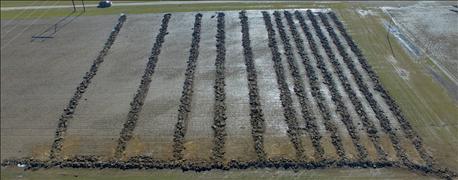October 25, 2016

Water management is a key component in crop production. Beck’s Ohio Practical Farm Research (PFR)® site implemented a multi-year tile spacing study in 2015 which focused on the return oN investment (ROI) of different tile spacings at 7.5, 20, 30, 40, and 50 ft. The 40 ft. tile spacing served as the control in this study as it was the traditional spacing used at Beck’s Ohio PFR site. Click here to view the 2015 tile spacing study results.

Installation of the tile spacing study at Beck’s Southern IL PFR site in the fall of 2015. Tile was installed at 60 ft., 30 ft., and 15 ft. widths.
Beck’s is conducting a second study at the southern Illinois (SIL) PFR site where tile spacing and tile depth are being compared. In this study, tile spacing of 15 ft., 30 ft., and 60 ft. are evaluated against a no tile control. Each spacing is being tested at a depth of 2 ft. and 3 ft. In 2015, significant differences were noticed early in the season in soil drying rates as the 15 ft. and 30 ft. tile spacing at both tile depths dried out at a much quicker rate than the 60 ft. spacing at either depth. No visual differences in the rate of drying or condition of the crop were noted between the 24 in. and 36 in. depth. However, the 36 in. tile depth did out yield the 24 in. depth by an average of 2.1 Bu./A.across all tile spacings.
In addition to tile spacing, Beck’s SIL site also has also been evaluating drip-irrigation. In 2016, this study had two treatments of drip line (one with and one without tile) that were compared to a tile alone treatment and an untreated (no tile and no drip line). In the drip line treatments, Netaphim drip line was placed 13 in. underground at 30 in. spacing with an emitter every 18 in. along the line. Treatments with tile were at a depth of 36 in. and a width of 30 ft. The greatest yield advantage was observed in the treatment with both a drip line and tile drainage. With the wet conditions experienced at this site, this treatment allowed for good, early season drainage. It also provided the opportunity to bring water in during the dry pollination conditions later in the season.
A third water management study, conducted at Beck’s SIL PFR site, is a sub-irrigation study. This study compares:
* Manual sub-irrigation
* A controlled water table
* Tile drainage
* Sensor based sub-irrigation
The manual sub-irrigation plot was drained early in the season and the water was held at the discretion of the PFR team later in the season. The controlled water table has a gate which holds natural water later in the season. The tile drainage is contoured tiling and draining all season long. The sensor based sub-irrigation system has sensors at 8 in. and 16 in. to monitor the average percent of the water table between the two sensors. When the water table value is at 75 percent or greater, most agronomists consider water to be sufficient, but when it reaches 50 percent, the sensors indicate water is necessary. In 2016, the products with genetics known to have drought tolerance had the greatest results with the controlled water table, resulting in a yield increase of 54.0 Bu./A. over the control. Products with genetics that are less tolerant to drought showed the sensor based sub-irrigation system to be best with a 41.5 Bu./A. increase.
Estimates on improved yield and ROI will be more conclusive with additional years of data. Full study results can be found in Beck’s 2016 PFR book which will be published later this year. For more information on Beck’s PFR, click here.
Practical Farm Research (PFR)® is a registered trademark of Beck’s Superior Hybrids, Inc.
You May Also Like




